
The Vought F4U Corsair is an American fighter aircraft which saw service primarily in World War II and the Korean War. Designed and initially manufactured by Chance Vought, the Corsair was soon in great demand; additional production contracts were given to Goodyear, whose Corsairs were designated FG, and Brewster, designated F3A.
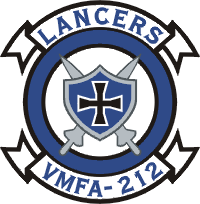
Marine Fighter Attack Squadron 212 (VMFA-212) was a United States Marine Corps F/A-18 Hornet squadron. Most recently known as the "Lancers", the squadron was last based at Marine Corps Air Station Iwakuni, Japan and fell under the command of Marine Aircraft Group 12 (MAG-12) and the 1st Marine Aircraft Wing. VMFA-212 has an extensive combat history having participated in combat operations during World War II, the Korean War, Vietnam War, the Gulf War, and Operation Enduring Freedom. Due to a re-organization within Marine aviation, the squadron was deactivated in 2008.
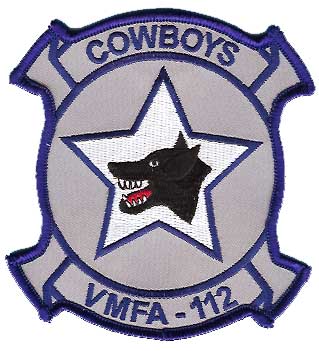
Marine Fighter Attack Squadron 112 (VMFA-112) is a reserve United States Marine Corps McDonnell-Douglas F/A-18 Hornet squadron. The squadron is based at NASJRB Fort Worth, Texas and falls under the command of Marine Aircraft Group 41 (MAG-41), 4th Marine Aircraft Wing. Their tail code is MA. During World War II the squadron saw extensive action throughout the Pacific Theater of Operations especially at the Battle of Guadalcanal as part of the Cactus Air Force. By the end of the war, its 140 air-to-air kills ranked it third among Marine Corps squadrons.

Marine Fighter Attack Squadron 323 (VMFA-323) is an aircraft carrier-based aviation squadron of the United States Marine Corps. The squadron is equipped with the McDonnell Douglas F/A-18C Hornet and is based at Marine Corps Air Station Miramar, California, United States. It falls under the command of Marine Aircraft Group 11 (MAG-11) and the 3rd Marine Aircraft Wing but deploys with the U.S. Navy's Carrier Air Wing 17 (CVW-17). Their tail code is WS and their radio callsign is Snake.

Marine Fighter Attack Squadron 311 (VMFA-311) is a United States Marine Corps fighter attack squadron consisting of F-35C Lightning II. Known as the "Tomcats", the squadron is based at Marine Corps Air Station Miramar, California and falls under the command of Marine Aircraft Group 11 (MAG-11) and the 3rd Marine Aircraft Wing.

Marine Fighter Attack Squadron 312 (VMFA-312) is a United States Marine Corps F/A-18C Hornet squadron. Also known as the "Checkerboards", the squadron is based at Marine Corps Air Station Beaufort, South Carolina and falls under the command of Marine Aircraft Group 31 (MAG-31) and the 2nd Marine Aircraft Wing. The Radio Callsign is "Check."
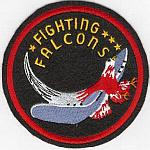
Marine Fighting Squadron 221 (VMF-221) was a reserve fighter squadron of the United States Marine Corps. Originally commissioned during the World War II, it flew the Brewster F2A-3, and after reconstitution in 1943, the F4U Corsair. The squadron, also known as the "Fighting Falcons", is most notable for its actions on 4 June 1942, during the Battle of Midway, which resulted in 23 members of the squadron, many posthumously, being awarded the Navy Cross for their actions in combat. VMF-221 ended World War II with 185 air-to-air victories, the second most of any Marine Fighting Squadron in the war.

Marine Fighter Attack Squadron 124 (VMFA-124) was a flying squadron in the Marine Forces Reserve based out of Naval Air Station Memphis flying the A-4 Skyhawk. They were part of Marine Aircraft Group 42 and were decommissioned on 19 June 1999. The squadron was the first Marine squadron to fly the F4U Corsair during World War II and also one of the first Marine squadrons to be based on an aircraft carrier. They were known as the "Wild Aces" and ended World War II with 78 air-to-air victories against Japanese aircraft.
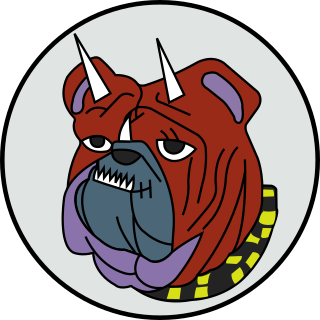
Marine Fighting Squadron 111 (VMF-111) was a reserve fighter squadron in the United States Marine Corps. Nicknamed the "Devil Dogs", the squadron was one of the first aviation squadrons in the Marine Corps and gained national attention in the 1930s as the Marine Corps show unit. The squadron fought in World War II and was later transferred to the Reserves where they fell under the command of Marine Aircraft Group 41 (MAG-41) and the 4th Marine Aircraft Wing while stationed at Naval Air Station Dallas, Texas. They were decommissioned on 22 October 1965.

Marine Fighter Attack Squadron 351 (VMFA-351) was a fighter squadron in the Marine Forces Reserve. The squadron was based at Naval Air Station Atlanta and participated in action during World War II and was decommissioned in 1975.
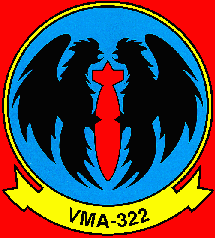
Marine Attack Squadron 322 (VMA-322) was an attack squadron in the United States Marine Corps. The squadron, also known as the "Fighting Gamecocks", fought in World War II and later became a part of the Marine Forces Reserve based out of Naval Air Station South Weymouth, Massachusetts.

Marine Transport Squadron 216 (VMR-216) was a reserve cargo squadron of the United States Marine Corps that was based out of Washington. Known as the "Bulldogs", VMR-216 started out as a fighter squadron and participated in numerous combat engagements in the Pacific Theater during World War II to include the Battle of Guam and the Battle of Iwo Jima. The squadron was decommissioned shortly after the end of the war but was reactivated in 1946 as part of the Marine Air Reserve. The squadron remained in the Reserve until being decommissioned on 21 December 1972.
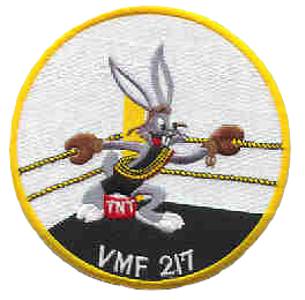
Marine Attack Squadron 217 (VMA-217) was a fighter squadron of the United States Marine Corps that was activated and fought during World War II. Known as "Max’s Wild Hares", they fought in many areas of the Pacific War including the Battle of Iwo Jima. Following the surrender of Japan, the squadron was deactivated on 10 March 1946. They were briefly reactivated as part of the Reserves but were again deactivated in 1964 and remain in an inactive status today.

Marine Fighting Squadron 215 (VMF-215) was a fighter squadron of the United States Marine Corps that was commissioned and fought during World War II. Known as "The Fighting Corsairs", the squadron fought in many areas of the Pacific War, including the Battle of Bougainville. During its four-and-a-half month tour, the squadron was credited with shooting down 137 enemy aircraft, fourth most in Marine Corps aviation history.

Marine Fighting Squadron 511 (VMF-511) was a fighter squadron of the Marine Corps and Marine Forces Reserve during World War II and the Cold War which flew aircraft types such as the F6F Hellcat, F4U Corsair, and the F-8 Crusader. They were originally activated during World War II and fought during the Battle of Okinawa and the Battle of Balikpapan (1945). They specialized in close air support and during the course of the war were credited with only one plane shot down.

Marine Fighter Attack Squadron 124 (VMFA-124) was a flying squadron in the Marine Forces Reserve based out of Naval Air Station Memphis flying the A-4 Skyhawk. They were part of Marine Aircraft Group 42 and were decommissioned on 19 June 1999. The squadron is best known as the first Marine squadron to fly the F4U Corsair during World War II and also the first squadron to be based on an aircraft carrier. They were known as the "Wild Aces" and ended World War II with 78 air-to-air victories against Japanese aircraft.
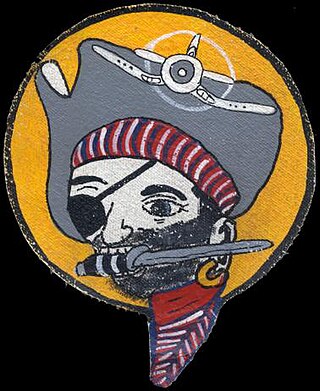
Marine Fighting Squadron 512 (VMF-512) was a fighter squadron of the United States Marine Corps during World War II. The squadron was aircraft carrier based during the last year of the war and supported combat operations during the Battle of Okinawa and the Battle of Balikpapan (1945). Following the end of World War II they were deactivated on 10 March 1946 and remain in an inactive status today.

Marine Night Fighter Squadron 532 was a United States Marine Corps night fighter squadron that was commissioned during World War II. The squadron, which flew the F4U-2 Corsair, was the second night fighter squadron commissioned by the Marine Corps, the first to fly a single-seat, radar-equipped night fighter, and the only Marine squadron to fly the F4U-2 in combat. VMF(N)-532 saw extensive combat operations throughout 1944 in support of Marine Corps operations at Kwajalein Atoll and the Mariana Islands. The squadron was decommissioned on 31 May 1947, as part of the post-war draw down of the service. Since then, no other Marine Corps squadron has carried the lineage and honors of VMF(N)-532.
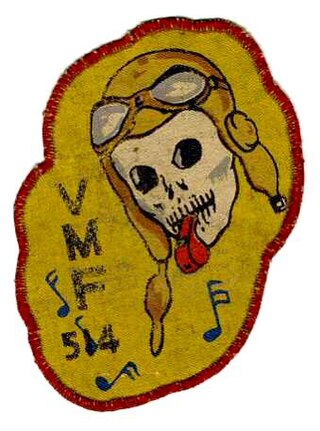
Marine Fighting Squadron 514 (VMF-514) was a short-lived fighter squadron of the United States Marine Corps during World War II. Flying the Vought F4U Corsair, the squadron was originally commissioned to be part of the ill-fated Project Danny, a plan for carrier based Marine Corps aircraft to interdict German V-1 flying bomb launch sites. The squadron did not participate in combat action during the war and was decommissioned on 9 December 1945. No other Marine Corps squadron has carried VMF-514's lineage and honors since that time.

Marine Attack Squadron 324 (VMA-324) was an attack squadron in the United States Marine Corps. Nicknamed the "Devil Dogs," the squadron was based out of Marine Corps Air Station Beaufort, South Carolina for most of its history however it spent its last three years at Marine Corps Air Station Yuma, Arizona. Originally commissioned during World War II as a fighter squadron, VMF-324 deployed to Midway Atoll during the later months of the war never participating in combat operations. Following a post-war decommissioning, the squadron was reactivated during the Korean War as an attack squadron. VMA-324 conducted regular training evolutions and world-wide deployments until it was decommissioned on 29 August 1974.

















